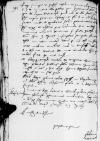Cras hinc iterum proficiscor in ⌊Prussiam⌋, missus a ⌊maiestate reginali⌋, quo tuear dominum ⌊Lucam de Allis⌋ capitaneum Rogosnensem ab illis, qui eum molestant. Subdidit enim se ⌊maiestati reginali⌋, tali condicione, quod post ⌊ipsius⌋ et ⌊consortis⌋ eius mortem maiestas reginalis debet districtum Rogosnensem possidere. Dimisit enim superioribus diebus 6000 florenos, de summa super eo inscripta, quod factum multi rident, utcumque ⌊maiestati suae⌋ bene factum est.
Heri legi ⌊⌋ Dominationis Vestrae Reverendissimae ⌊maiestati regiae⌋ et ⌊reginali⌋ ex ⌊August[a]⌋ 1530-07-02⌊2 huius1530-07-02⌋ scriptas, ubi se Dominatio Vestra subscripsit et addidit manu propria se eodem die fascem litterarum huc misisse, qui adhuc desideratur. Maxime a me, qui super multis meis scriptis resolutionem exspecto, ob eam rem fratri meo, qui hic ⌊iuveni regi⌋ servit commisi, ut, si me absente litterae adferentur, mihi cum primis in ⌊Prussiam⌋ mittat. Cogebor enim illic immorari usque in futurum Septembris (ut reor).
Nunc potissimum ob hoc Dominationi Vestrae scribo, quo depingam, quam benevolo animo ⌊maiestas reginalis⌋ eius saepissime meminit, dicit se summopere gaudere de occasione evectionis Dominationis Vestrae. “Tu scis’’- inquit – “Fabiane, quoties tibi adhuc ⌊Villnae⌋ dixi me haec optare. In summa benissime omnia”. Praeterea primates multi Itali omnes paucissimos comparandos in hoc regno esse Dominationi Vestrae praeferendum forsan nullum. Quae res cum me summo gaudio toties afficit, non possum silentio transire.
Rogo summopere, ut possum resolvi (uti prius aliquoties scripsi) de iuvene illo Petro, qui ⌊Pyotrcovie⌋ domino ⌊Georgio de Laxo⌋ datus est, quid nam de illo factum sit. Itaque cupio scire, an ⌊Georgius⌋ frater Dominationis Vestrae cum Ludovico socero meo, et gradario salvi pervenerint ad Dominationem Vestram. Itaque rogo et obsecro pro ⌊Columba⌋ Dominationis Vestrae, antequam in manus aliorum deveniat, si fieri potest. Cogor enim hic 3 equos inscriptos semper fovere, esset in rem meam. Verum si non est in fatis, certe nolim ambire, nam in eiuscemodi rebus a Dominatione Vestra Reverendissima doctus. Deo me commendo. Hic quid volet, fiat ex me etc.
Dominus ⌊Seczignewski⌋ orator, ex ⌊Ungaria⌋ huc missus aeger praeteritis diebus febri continua huc cum advenisset 6 vel 7 die obiit. Homo dexter sine dubio, requiescat in sancta pace.
⌊Maiestas regia⌋ optime valet, saepe in ⌊Nepolomicze⌋ venatum cum ⌊maiestate reginali⌋, serenissimo ⌊filio⌋ et duabus reginulis proficiscitur.
⌊Iuvenis rex⌋ Latine a ⌊Siculo⌋ pleno scientiarum a domino ⌊Petro Opalinski⌋ [magistro curiae] Germanice imbuitur. Ego cum fratre a longe sequimur, quem una mecum iterum humiliter commendo.


